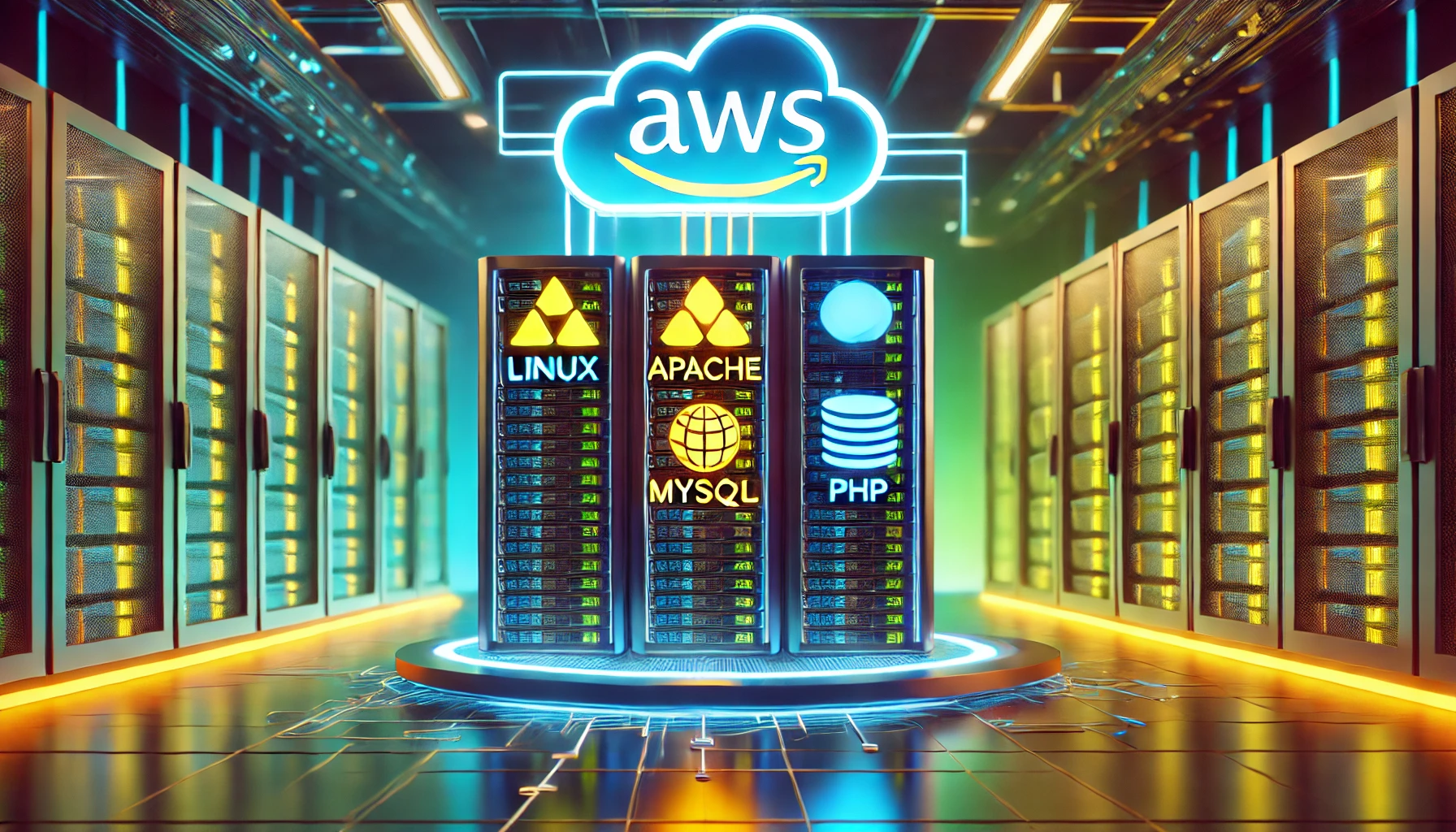Lamp Stack On Aws
 Kiran Pawar
Kiran Pawar
Table of Content
LAMP STACK ON AWS
What Problem does LAMP stack solve?
Deploy a LAMP stack manually on AWS
Steps 0 - Prepare prerequisites
Step 1 - Install Apache and update the firewall
Step 2 - Install MySQL
Step 3 - Install PHP
Step 4 - Configure Apache Virtual Host
Step 5 - Enable PHP on the website
Step 6 - Create PHP script to test the configuration of PHP
Conclusion
What Problem does LAMP stack solve?
The LAMP stack is a framework for hosting web applications. It is based on Linux as the operating system, Apache as the web server, MySQL as the Database and PHP as the scripting language. PHP can be substituted with Python or Perl.
It provides a comprehensive and reliable platform for building and hosting a wide range of web applications, from small personal websites to large-scale enterprise applications. Despite the emergence of new technologies, LAMP is still widely in use for web development because of it's proven reliability, cost effectiveness and versatility.
Deploy a LAMP stack manually on AWS
Steps 0 - Prepare prerequisites
Create an AWS Account
Spin up an Ubuntu OS EC2 instance on AWS
If successful, The console should display your EC2 instance running like this:
- Download the private key preferably to the
.sshdirectory and cd into the directory:
cd .ssh
- Change permissions for the private key file:
sudo chmod 0400 <private-key-name>.pem
- Connect to the ubuntu instance by running :
ssh -i <private-key-name>.pem ubuntu@<publi-ip-address>
Step 1 - Install Apache and update the firewall
Apache is the web server that serves our web content to the end user.
- Update the package list and install Apache
# Update package list
sudo apt update -y
sudo apt upgrade -y
# Install Apache web server
sudo apt install apache2 -y
- Adjust the firewall:
First check if the UFW is active with the following command:
sudo ufw status
if the Status: inactive, skip this step. Otherwise, allow apache traffic with the following command:
sudo ufw allow 'Apache Full'
- Next, verify that Apache is running:
sudo systemctl status apache2
- Access Apache locally with curl:
curl http://localhost:80
Running curl http://127.0.0.1:80 gives the same result.
Alternatively, you can access it on any web browser of your choice by checking the following address:
http://<EC2-instance-public-ip>:80
Note: To retrieve the public IP of your EC2 instance, visit the AWS management console or run the following command on the terminal:
TOKEN=`curl -X PUT "http://169.254.169.254/latest/api/token" -H "X-aws-ec2-metadata-token-ttl-seconds: 21600"` && curl -H "X-aws-ec2-metadata-token: $TOKEN" -s http://169.254.169.254/latest/meta-data/public-ipv4
When you view the web browser, what you see is similar to the image below:
Step 2 - Install MySQL
To be able store and manage data for our web application in a relational database, we will install MYSQL.
- Install mysql with apt
sudo apt install mysql-server -y
- Login to the MYSQL console by typing:
sudo mysql
This will connect mysql a the administrative database user root
Following best practice, it is recommended to run a security script that comes pre-installed with MYSQL to remove some insecure default settings and lock down access to the database system. Before we do this, we will set a password for the root user. For simplicity, we will use password123@. We will be using mysql_native_password as the default authentication method:
- Set MYSQL root user password:
ALTER USER 'root'@'localhost' IDENTIFIED BY 'password123@';
- Exit the MYSQL shell:
exit
- Secure mysql installation by starting the interactive script:
Run the security script:
sudo mysql_secure_installation
Follow the following :
- VALIDATE PASSWORD COMPONENT is used to test password and improve security: For now, we will enter
YforYES. We should use stong unique passwords for database credentials.
We are then prompted to choose from three levels of password validation policy. We will go with 1 = MEDIUM. Note that the strong password setting is very strict and must comply with the stated rule as seen in the image above.
Next we will be asked to set password if the password we already set does not match the specification in the password validation policy.
Because the password we set already matches the specification, password creation is skipped as shown.
Next we are asked to remove Anonymous Users?: Press
Y.Disallow Root Login Remotely?: Press
Y.Remove Test Database and Access to it?: Press
Y.Reload Privilege Tables Now?: Press
Y.
- Test if you are able to login to the MYSQL shell by typing:
sudo mysql -p
if successful, you should be able to login. You can exit the MySQL monitor by entering exit
It is recommended to create dedicated users for each databases.
MySQL has been installed and we can proceed to install PHP.
Step 3 - Install PHP
Now we install PHP to process code and to display dynamic content to the end user. We will install the php package, php-mysql which is a php module that php uses to communicate with MYSQL-based database; and libapache2-mod-php which enables Apache to handle PHP files.
- Run the following command to install the 3 necessary packages:
sudo apt install php libapache2-mod-php php-mysql
Core PHP packages will be automatically installed as dependencies.
We can also optionally install other php modules:
sudo apt install php-cli php-curl php-gd php-mbstring php-xml php-xmlrpc php-zip -y
- Verify PHP installation by checking the version:
php -v
if php has been successfully installed, you will get an image similar to the one below:
Our LAMP is now succesfully installed and ready to be used. We will test our set up with as PHP script. We will follow best practice by setting up an Apache Virtual Host to hold our website files and folders. A virtual host allows us to serve multiple websites on one single host machine.
Step 4 - Configure Apache Virtual Host
We will create a directory next to the default one at /var/www/html
- Create a directory named
lamp_projectas follows:
sudo mkdir /var/www/lamp_project
Currently, if you check the dircetory ownership using ls -la /var/www/lamp_project, it may be owned by root or another user.
- Next, we will set the correct permissions:
sudo chown -R $USER:$USER /var/www/lamp_project
- Create a new configuration file in apache's
sites-availabledirectory.
sudo vi /etc/apache2/sites-available/lamp_project.conf
Add the following to the configuration file:
<VirtualHost *:80>
ServerName [your_project_name or domain_address]
ServerAlias [www.your_project_name or www.yourdomain.com]
ServerAdmin webmaster@localhost
DocumentRoot /var/www/[your_project_name]
ErrorLog ${APACHE_LOG_DIR}/error.log
CustomLog ${APACHE_LOG_DIR}/access.log combined
</VirtualHost>
We will replace [your_project_name or domain_address] with lamp_project which is the name of our directory.
Though, including the ServerAdmin directive is a good practice for proper server administration and communication, it's not strictly required for the virtual host to function. If you don't want to specify an admin email, you can omit this line from your virtual host configuration without affecting the website's operation. In production environment, many organizations use role-based email addresses like webmaster@yourdomain.com for this purpose.
- Save the file by hitting
esckey and:wq
The virtualhost configuration gives a directive to apache to serve lamp_project using /var/www/lamp_project as the web root directory.
- Enable the new virtual host:
sudo a2ensite lamp_project.conf #replace this with the name of your project file
For consistency we have appended the full name of the file. If we write it without .conf, it also works. In practice, Apache will first look for an exact match of the name of the file you provide. If it doesn't find an exact match, it will then look for a file with .conf appended.
- Disable Apache default website:
sudo a2dissite 000-default.conf
- Test the configuration file:
sudo apache2ctl configtest
- Reload Apache to ensure that the changes take effect:
sudo systemctl reload apache2
- Create an index.html file in the project root to test that the virtual host works as expected:
sudo echo 'HELLO LAMP from hostname' $(TOKEN=`curl -X PUT "http://169.254.169.254/latest/api/token" -H "X-aws-ec2-metadata-token-ttl-seconds: 21600"` && curl -H "X-aws-ec2-metadata-token: $TOKEN" -s http://169.254.169.254/latest/meta-data/public-hostname) 'with public IP' $(TOKEN=`curl -X PUT "http://169.254.169.254/latest/api/token" -H "X-aws-ec2-metadata-token-ttl-seconds: 21600"` && curl -H "X-aws-ec2-metadata-token: $TOKEN" -s http://169.254.169.254/latest/meta-data/public-ipv4) > /var/www/lamp_project/index.html
Here we use the instance metadata to retrieve the hostname and public-IP of our instance. The AWS Documentation is a great resource to find out details on how to use the instance metadata. The instance metadata categories are found here
- Visit your web browser and enter the public IP of your EC2 instance as shown:
http://[Public-IP]:80
The output should show our server's public hostname (DNS name) and server's public IP address. We can also use access the website through the DNS name without mapping it to the port 80
The index.html file can be kept as a placeholder until we replace it with our index.php file
Step 5 - Enable PHP on the website
Apache has a default DirectoryIndex in which the index.html file takes precedence over an index.php file. The real life application of this is that the index.html file can be used as a temporary landing page to display an informative message to visitors especially during routine system maintenance. Once maintenance is aover, it is either renamed or removed, thereby bringing up the regular application page.
This default behaviour can be changed by editing the /etc/apache2/mods-enabled/dir.conf and changing the order in which the `index.php is listed in the DirectoryIndex directive.
- To do this, run the command:
sudo vim /etc/apache2/mods-enabled/dir.conf
- In the file, bring index.php to the fore front as shown:
- Reload apache so that the changes take effect:
sudo systemctl reload apache2
Step 6 - Create PHP script to test the configuration of PHP
- Create a new file named
index.phpin the custom project folder:
sudo vim /var/www/lamp_project/index.php
- Add the following text:
<?php
phpinfo();
- Save and close the file. then refresh the webpage. What you see is similar to the image below:
The page provides useful info about your server from the perspective of php. this means php is installation is properly configured. The page contains sensitive info about your PHP environment and virtual machine. Hence, it should be removed with the command below:
sudo rm /var/www/lamp_project/index.php
Conclusion
We successfully deployed a LAMP stack on AWS Cloud!
Subscribe to my newsletter
Read articles from Kiran Pawar directly inside your inbox. Subscribe to the newsletter, and don't miss out.
Written by

Kiran Pawar
Kiran Pawar
"Hello, I'm Kiran Pawar, a passionate Cloud and Devops Engineer with a strong background in cloud automation, configuration, and deployment. My journey in the world of technology has been a thrilling adventure, where I've had the privilege to work with cutting-edge tools and practices. 🚀 As a DevOps Engineer: I specialize in automating, configuring, and deploying instances in cloud environments and data centers. My expertise extends to DevOps, GitOps, CI/CD pipeline management, HashiCorp Terraform, and containerization. I'm proficient in AWS and Linux/Unix administration, ensuring robust infrastructure and application performance. 🔧 My Tech Stack: Front-end skills: HTML, CSS, SCSS, Tailwind CSS, Bootstrap, React, Material-UI, JavaScript DevOps toolbox: GIT, OWASP,Nexus,Trivy, Github, Gitlab, Terraform, Ansible, Docker, Kubernetes, Helm, Jenkins, Prometheus, Grafana, Argo CD, AWS EKS. 🌐 My Cloud Expertise: I have hands-on experience managing AWS services, including EC2, S3, EBS, VPC, ELB, RDS, IAM, Route53, and more. 🔒 Networking and Security: My skills include managing networking concepts such as TCP/IP protocols, security policies, and subnet interfacing. I have a strong understanding of infrastructure and networking, covering topics like firewalls, IP addressing, DNS, and more. 💡 What Sets Me Apart: I bring a positive attitude, a strong work ethic, and a collaborative spirit to every project. I'm a self-starter, a fast learner, and an effective team player with strong interpersonal skills. In addition to my DevOps skills, I've developed shell scripts (Bash) for automating tasks and have proficiency in Python scripting. My ability to communicate and manage projects, along with a track record of resolving client issues, adds value to every team I work with. If you're looking for a DevOps engineer who is also well-versed in front-end technologies, feel free to connect with me. Let's explore new possibilities and create exceptional technical solutions together!"

















